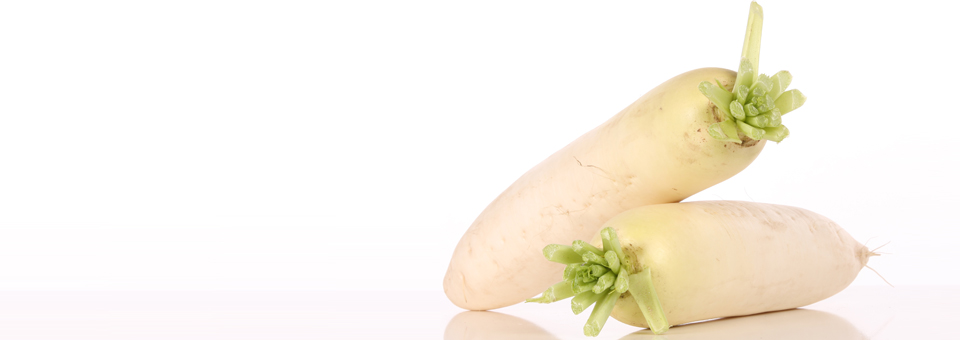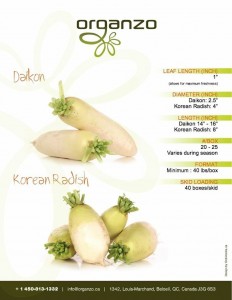Daïkon
Introduction
At Organzo, we distinguish between daikon and lo bok because of their different diameters and lengths. In fact, daikon, 2 to 2.5 inches in diameter, is usually longer than lo bok which tends to be short with a diameter of at least 3 inches, but it is the same vegetable.
We differentiate between the varieties of Oriental radish by:
-
the intended use of the leaves and roots,
-
its shape, whether round, long and slender or short,
-
its colour which varies from pure white (almost pearly) to pink, black, red, green or white and green.
The varieties that we sell are no longer than 30cm and have a slender shape.
This giant white radish has soft and refreshing flesh, its flavour is mild and sweet at the top and peppery at the bottom, and varies depending on the type of soil and amount of sunlight. Its texture is crunchy and its skin is delicate and smooth.
Daïkon is made up of 94% water; it is a gold mine of health benefits, low in calories and rich in vitamins and myrosinase active enzymes which guarantee good digestion. It facilitates the digestion of fats. Daikon is recommended for people with a fragile stomach as it fights acidity.
Did you know: Although it is considered to be a root vegetable, we do not actually eat the root of the radish; it is the hypocotyl, a stem bulge situated between the stem and the root. The root and its rootlets are underneath and extend the hypocotyl.
Organzo: a strategic and authentic partnership between truck farmers and our agronomic services department, from seed to harvest.
We constantly suggest new varieties to improve product qualityand options for seeds that are less prone to ravagers, diseases and physiological disorders.
We walk through the producers’ fields every week looking at and inspecting the slightest defaults in plants, in order to delay any outbreak of ravagers and/or diseases by applying good agricultural practices, and when needed, by rationally using registered pesticides.
Selection and preservation
Select a white, heavy, firm daikon that is free of marks and bruises. Choose one that has shiny skin and fresh leaves that are small to medium in size.
Despite its appearance, the Oriental radish is a fragile vegetable as it softens and dries out quickly. Keep the hypocotyl in the fridge without washing it for three to four days in a perforated plastic bag to ensure it doesn’t dry out. If the whole thing is not consumed in one sitting, it can be kept for up to a week, but it is recommended to cook it rather than eating it raw.
Cooking instructions
When you’re ready to prepare it, wash and peel it. You can either grate it like a carrot or cut it into thin slices then sautée it in a wok or frying pan.
Use the upper part, often sweeter (in sauces and soups) and the lower part which is more peppery (in salads).
We can eat it raw (salads or dips), as a condiment (particularly for sushi) or cooked. It keeps its firmness and consistency even when cooked for a long time, but it loses its crunchiness and taste.


